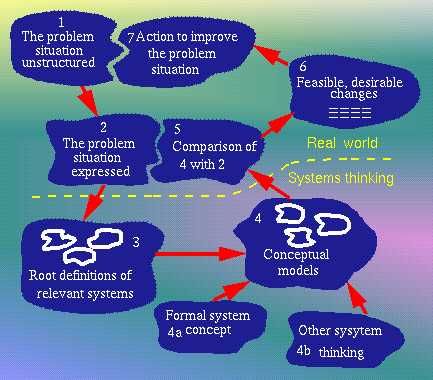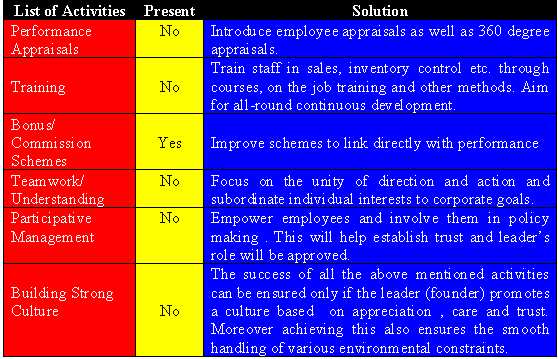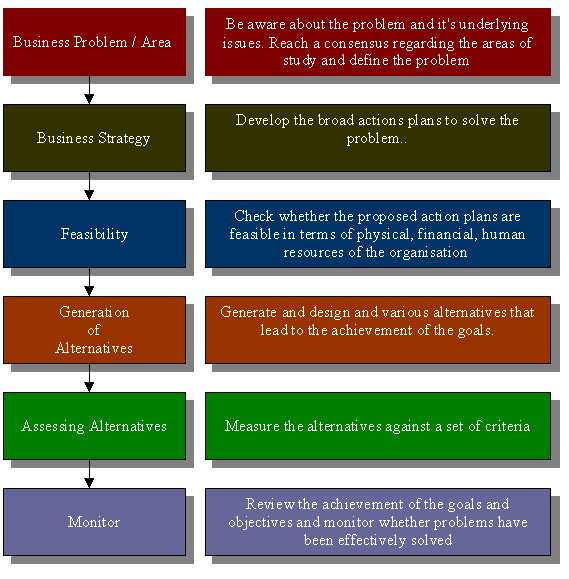
Topic 3
Diagnosis and Systems Thinking
Chapter 2 in
David Jennings and Stuart Wattam (2000)
"Decision Making - An Integrated Approach" : Pitman Publishing
Key points in this chapter :
Ñ What is Systems Approach
Ñ Entropy
Ñ Closed and Open Systems
Ñ Soft Systems Methodology
Ñ Hard Systems Methodology
The lowest form of thinking is the bare recognition of the object. The highest , the comprehensive intuition of the man who sees all things as part of a system. – Plato
Introduction
In the modern, dynamic world we are all faced with a plethora of multifaceted difficulties and problems. A problem is any situation for which we need new ideas or plans. It is the gap between where we are and where we want to be. The technological upheavals and cultural revolutions have imposed new adaptations on the society, widening the gap between the perception of the global problems and formulation of their solutions. Such sets of interacting problems and messes call for a systems approach to problem-solving.
System Approach
Inorder to use the Systems Approach "a problem-solver must understand the entire organisation in systemic terms, which can only be achieved by developing a whole systems view of the organisation in focus”. To do this, four key organisational dimensions must be understood:
Processes – the various inflows and outflows of information or matters in the system as well as the feedback loops.
Design – the formal and informal structures and functions, co-ordination and control.
Culture – values, beliefs, norms, underlying assumptions or simply "the way things are done"
Politics – the power structure of the different stakeholders.
A comparison of simple and complex systems can be seen in the table below:

The relationship between concepts and problems is developed by examining two major approaches to analysis - soft and hard systems based methodologies, and their application to problem situation.
A comparatively simple example of a system is provided by a timing device. The behaviour of the system is predetermined because it is a closed system.: the system exists in an environment but the system can be seen as not interrelating with that environment. The system at some stage contains energy from a battery or through a spring mechanism, but will lose that energy over the course of time. In systems theory this phenomenon is called entropy. Human beings, forests, business organisations can all be analysed as open systems.

Fig: An open systems model
It is common for business problems to be identified and treated as marketing or accounting or stock problems, or be given some other functional label. However, a problem is often caused by a number of areas of the business. In addition, the failure to co-ordinate and integrate activities is often a significant part of an organisation's problems. The systems approach provides a means of considering the whole system and the linkages within it.
Soft Systems Methodology
Implementation: The various stages of Soft Systems Methodology are analysed below

Fig : The process of soft systems methodology.
Stage 1 and 2 - Finding out:
Inorder to capture as much as possible of the 'real-world' situation a soft systems analysis begins with the analyst seeking a broad view of the situation. This information, gathered through interview, from documents and observation, is shown as a rich picture.
Stage 3 - Formulating root definition:
Stage three is concerned with building various themes and formulating a root definition. The aim is to draw out the essence of what is to be done, why it is to be done, who is to do it, who is to benefit/ suffer from it and what environmental constraints limit the action and activities. This is achieved by formulating the statement around six elements of the CATWOE statement:
1) Customers: those who would receive the immediate output from the relevant system.
2) Actors: those who would be directly involved in making the relevant system work as a process.
3) Transformation Process: what the relevant system does in terms of transforming inputs into outputs.
4) Weltanschauung: German word meaning 'world view' or fundamental set of values and assumptions implicit in the root definition.
5) Owners: person or body ultimately speaking for the nature and purpose of the relevant system based on their potential control over it's existence or otherwise.
6) Environmental Constraints: those things which strongly affect or distrub the system, but over which the system has only limited influence or control.
Stage 4 - Building conceptual models:
A conceptual model is constructed by drawing out the minimum number of verbs (action plans) that are necessary to describe the activities that would have to be present to carry out the task named in the root definition. Various sub-systems can also be arranged, in a logical manner, which are concerned with the operation of the system as a whole
Stage 5 - Comparing models and reality:
Having built the conceptual model it is necessary to compare the list of activities with those already existing in the present. This process helps to highlight the likely changes that would have to be made to bring ‘reality’ closer to the ‘ideal holistic conceptual model’.

Fig : An example of the conceptual model

Fig: An example of comparing reality with the conceptual model.
Stage 6 - Defining changes:
By comparing the conceptual model to the real world, the analyst is able to identify differences between the two. In reality, certain activities may be missing, poorly performed or the linkages may be missing. The task here should be to identify all such changes required and to move towards the final stage i.e. taking action.
Stage 7 - Taking action:
Finally various changes - structural, procedural and attitudinal have to be implemented.
Structural changes may be to reporting structures, performance appraisals, reward schemes, participative decision-making etc.
Procedural changes may be in the process of appraisals (group, individual; formal, informal), the incentives for motivation, reporting procedures (verbal, written), process of training etc.
Attitudinal changes are intangible but are very important in bringing changes in the expectations, which employees have of the above changes. The structural and procedural changes can in-turn act as a symbolic activity to bring attitudinal changes. Attitudinal changes should be monitored continuously as they occur steadily through shared experiences
Hard Systems Methodology
Hard systems analysis links closely with the organisation's goals and objectives. The boundary is also set by consideration of why the analysis is to be done, what is to be done during the systems study, and what time-scale, resources, and commitment are present. Some systems are 'hard closed systems' such as production cycles, while others are 'open soft systems' such as customer care.

Fig: Hard Systems Approach
Decision-Making Academic Homepage